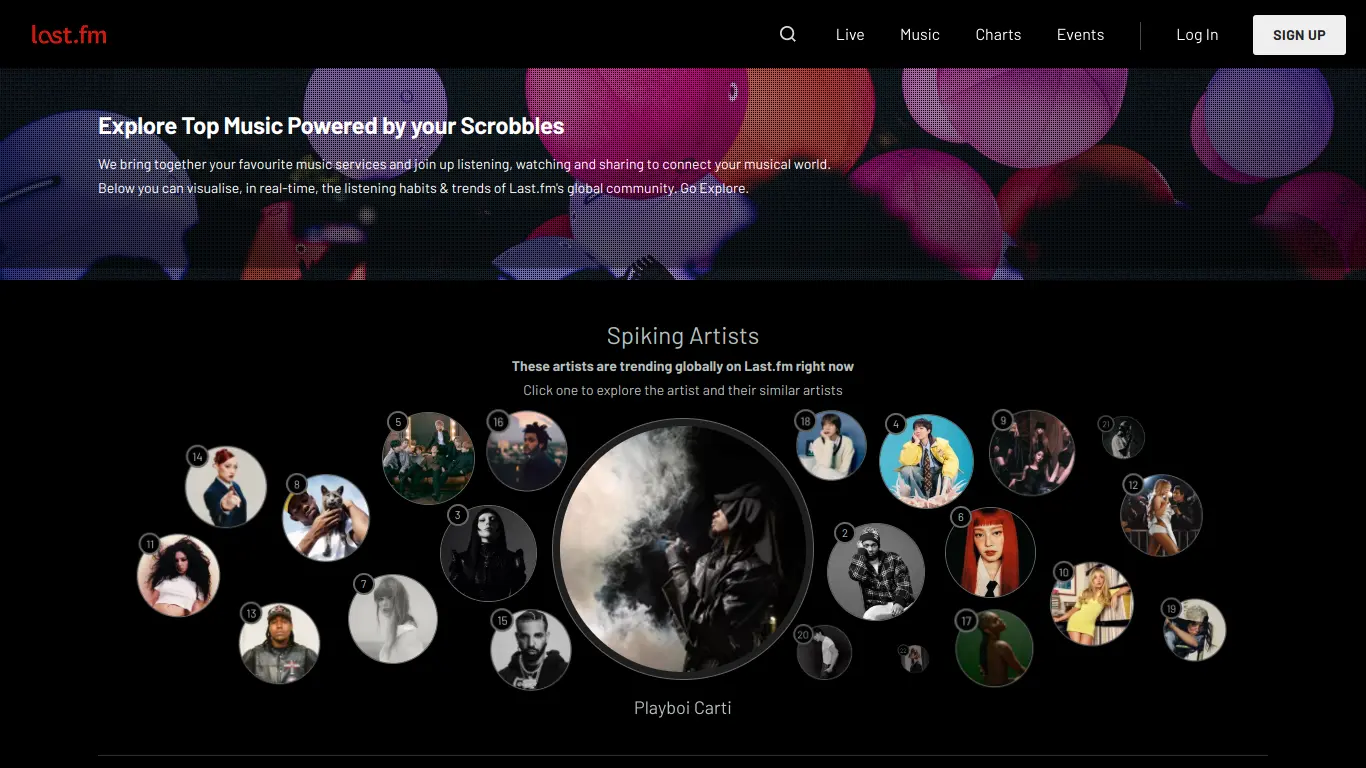Last.fm tracks your music across platforms, creates personalized recommendations, and connects you with like-minded listeners.
Are you tired of discovering new music through algorithms that just don’t get your taste? Do you wish there was a platform that could track your listening habits while connecting you with like-minded music fans? If you’re nodding along, you’re not alone. Music discovery has become increasingly challenging despite—or perhaps because of—the overwhelming amount of content available today. This is where Last.fm comes in, a platform that’s been revolutionizing how we discover and share music for over 17 years.
Introduction to Last.fm
What is Last.fm and its Purpose?
Last.fm is a music discovery service founded in the UK in 2002 that combines elements of a social network with powerful music recommendation technology. At its core, Last.fm “scrobbles” or tracks the music you listen to across various platforms (like Spotify, Apple Music, YouTube, and more), creating a detailed profile of your musical taste. This data is then used to recommend new artists, albums, and tracks that align with your preferences.
Unlike traditional streaming services that rely solely on algorithmic recommendations or editorial playlists, Last.fm leverages the collective listening habits of its user base to create what they call a “social music revolution.” The platform’s purpose is threefold:
- Track your music listening history across multiple platforms
- Provide personalized music recommendations based on your taste
- Connect you with a community of users who share similar music preferences
The service operates on the principle that the best music recommendations come from a combination of your own listening patterns and those of people with similar taste—a concept they pioneered long before the streaming giants of today.
Who is Last.fm Designed For?
Last.fm appeals to a diverse range of music enthusiasts:
- Music Discovery Seekers: People who want to expand their musical horizons beyond mainstream recommendations
- Data Enthusiasts: Users who enjoy analyzing their listening patterns and seeing statistics about their music consumption
- Music Collectors: Those who take pride in building and showcasing their musical taste and collection
- Community-Oriented Listeners: People who want to connect with others through shared musical interests
- Artists and Industry Professionals: Musicians and music industry workers looking to understand listening trends and fan behavior
Whether you’re a casual listener or a hardcore audiophile, Last.fm offers something for everyone who cares about music beyond just pressing play.
Getting Started with Last.fm: How to Use It
Starting your Last.fm journey is straightforward:
- Create an account: Visit Last.fm and sign up for a free account.
- Connect your music services: Link Last.fm to your preferred music streaming platforms. This can be done through:
- Official integrations with services like Spotify and Apple Music
- The Last.fm desktop app (Scrobbler) for local music files
- Browser extensions for YouTube and other web players
- Mobile apps that capture your listening on the go
- Start scrobbling: Once connected, Last.fm will automatically begin tracking your listening history. Every track you play counts as one “scrobble.”
- Explore your profile: After accumulating some listening data, visit your profile to see personalized stats, recommendations, and potential music matches.
- Engage with the community: Follow friends, join groups, and participate in discussions about your favorite artists and genres.
The real magic of Last.fm happens over time as it collects more data about your listening habits, making its recommendations increasingly accurate and personalized.
Last.fm’s Key Features and Benefits
Core Functionalities of Last.fm
Last.fm offers several standout features that have helped it maintain relevance in an increasingly competitive music tech landscape:
Scrobbling Technology
The foundation of Last.fm is its scrobbling capability, which records every track you listen to across connected platforms. This creates a comprehensive listening history that:
- Tracks artists, albums, and songs you’ve played
- Records timestamps of when you listened
- Calculates play counts for each track
- Identifies listening trends over time
Music Recommendations
Based on your scrobbling data, Last.fm generates recommendations through:
- “Similar Artists” suggestions based on your favorites
- “Recommended Radio” stations tailored to your taste
- Weekly discovery playlists featuring new releases you might enjoy
- Personalized event recommendations for concerts in your area
Community Features
Last.fm isn’t just about algorithms—it’s about people:
- User profiles showcase listening history and taste
- Friend connections allow you to follow others with similar interests
- Discussion forums for artist and genre-specific conversations
- Shoutboxes enable direct communication between users
Data Visualization and Statistics
For the analytically minded, Last.fm offers detailed insights:
- Weekly, monthly, and yearly listening reports
- Visual representations of your musical taste
- Compatibility ratings with other users
- “Musical neighbors” who share your taste profile
Advantages of Using Last.fm
The benefits of incorporating Last.fm into your music listening routine are numerous:
Unified Listening History
Last.fm consolidates your listening across platforms, giving you a complete picture of your music consumption regardless of where you listen. This is invaluable in today’s fragmented streaming landscape.
Personalized Discovery
Unlike generic algorithms, Last.fm’s recommendations are based on both your individual history and the collective wisdom of users with similar taste, resulting in more nuanced and unexpected discoveries.
Ownership of Your Data
While streaming services keep your listening data within their walled gardens, Last.fm gives you portable, visualized access to your complete listening history—something many users find valuable for both practical and nostalgic reasons.
Community Connection
Music is inherently social, and Last.fm facilitates connections based on shared taste that might not occur otherwise, bridging geographical and cultural divides through common musical interests.
Artist Insights
For musicians and industry professionals, Last.fm provides valuable data about listener demographics, geographic distribution, and related artists that can inform marketing and touring strategies.
Main Use Cases and Applications
Last.fm serves various purposes depending on how users choose to engage with it:
📊 Personal Music Analytics
Many users value Last.fm primarily as a data tracker, using it to:
- Analyze listening patterns over time
- Identify their most played artists and tracks
- Remember songs they discovered but might otherwise forget
- Create year-end summaries of their music consumption
🎵 Music Discovery Tool
Last.fm excels at helping users find new music through:
- Artist recommendations based on listening similarities
- Exploring the libraries of compatible users
- Discovering deep cuts from familiar artists
- Finding niche genres that align with taste profiles
👥 Social Music Network
The platform functions as a specialized social network where:
- Users connect based on musical compatibility
- Music tastes serve as conversation starters
- Community members share discoveries and recommendations
- People find concert companions with similar interests
🎸 Artist Promotion Platform
Musicians and labels use Last.fm to:
- Build artist profiles with comprehensive information
- Track listener demographics and geographic distribution
- Promote upcoming releases and tour dates
- Connect directly with engaged fans
Exploring Last.fm’s Platform and Interface
User Interface and User Experience
Last.fm’s interface balances data-rich presentations with accessibility, though it has evolved significantly since its early days:
Dashboard and Profile Layout
The main dashboard presents a mix of personalized elements:
- Recent scrobbles display what you’ve been listening to lately
- Statistics highlight your top artists and tracks
- Recommendations suggest new music based on your history
- Activity feed shows what your friends are listening to
Navigation Structure
The site is organized around several key sections:
- Music: Browse artists, albums, tracks, and charts
- Events: Discover concerts and festivals related to your taste
- Community: Connect with other users and join discussions
- Your Library: Access your personal listening history and favorites
Visual Design Philosophy
Last.fm’s aesthetic has modernized over time, now featuring:
- A clean, responsive design that works across devices
- Data visualizations that make statistics engaging and comprehensible
- Artist images and album artwork that create a visually rich experience
- Color schemes that help distinguish between different sections
User Experience Considerations
The platform prioritizes certain UX elements:
- Quick access to scrobbling status to ensure tracking is working
- Easy correction tools for misidentified tracks or artists
- Streamlined compatibility checking between users
- Intuitive exploration paths that encourage musical discovery
Platform Accessibility
Last.fm offers multiple ways to access and interact with the service:
Web Platform
The primary Last.fm experience is through its website, which offers:
- Full feature access from any modern browser
- Responsive design that adapts to desktop and mobile viewing
- Regular updates without requiring user downloads
Mobile Applications
Last.fm offers dedicated mobile apps for:
- iOS devices with Apple Music integration
- Android devices with various streaming service connections
- These apps focus primarily on scrobbling and basic profile viewing
Desktop Scrobbler
For those who listen to local music files, Last.fm provides:
- A desktop application that tracks plays from media players
- Integration with popular players like iTunes, Winamp, and foobar2000
- Background operation that doesn’t interrupt the listening experience
Third-Party Integrations
Last.fm’s API has spawned numerous third-party tools:
- Alternative mobile apps with enhanced features
- Browser extensions for YouTube and SoundCloud tracking
- Widgets for embedding Last.fm data on other websites
- Visualization tools that create artwork from listening data
Last.fm Pricing and Plans
Subscription Options
Last.fm operates on a freemium model, with most core functionality available at no cost:
| Plan | Price | Billing Options |
|---|---|---|
| Free | $0 | N/A |
| Pro Subscription | $3/month | Monthly or Annual ($30/year) |
The pricing structure is refreshingly straightforward compared to many modern services, with just two tiers and no complicated feature matrices to navigate.
Free vs. Paid Features
Last.fm has maintained a generous free tier that includes most essential functions:
Free Features:
- Unlimited scrobbling across platforms
- Basic listening statistics and recommendations
- Standard profile customization
- Community participation and social features
- Artist and album information access
Pro Subscription Benefits:
- Ad-free browsing experience throughout the site
- Enhanced statistics with deeper historical analysis
- Early access to new features and improvements
- Priority support for technical issues
- Supporter badge on your profile
What’s notable about Last.fm’s approach is that the Pro subscription feels like a way to support a service you value rather than a necessity to unlock core functionality. The free tier offers a complete experience that satisfies most users’ needs.
Last.fm Reviews and User Feedback
Pros and Cons of Last.fm
Based on user feedback and expert reviews, here’s how Last.fm’s strengths and weaknesses stack up:
Pros:
✅ Unmatched music tracking across multiple platforms
✅ Rich statistical insights into listening habits
✅ Community-powered recommendations that often outperform algorithmic alternatives
✅ Extensive artist database with detailed information
✅ Long-running service with established reliability
✅ Portable listening history independent of any single streaming service
Cons:
❌ Interface updates have sometimes removed beloved features
❌ Mobile apps lack some functionality of the web version
❌ Occasional scrobbling reliability issues with certain platforms
❌ Community aspects have received less development focus in recent years
❌ Limited integration with some newer streaming services
❌ Less immediate utility for podcast or audiobook listening
User Testimonials and Opinions
The Last.fm community is notably passionate about the service. Here’s what actual users have to say:
“I’ve been scrobbling since 2006, and my Last.fm profile is basically a diary of my life through music. I can look back at any period and see exactly what I was listening to—it’s like a time machine.” – MusicFan82
“The recommendations are uncannily good. Spotify suggests mainstream artists that sound similar, but Last.fm connects me with obscure bands I would never find otherwise, simply because people with my exact taste are listening to them.” – AlternativeSeeker
“As someone who uses multiple streaming services, Last.fm is the glue that holds my musical identity together. Without it, my listening history would be fragmented across platforms.” – StreamHopper
“The statistics are addictive. I find myself making listening choices based on filling gaps in my library or achieving certain milestones on my profile.” – DataMelody
The sentiment among long-term users is particularly strong, with many maintaining profiles for 10+ years and considering their scrobble history an important personal archive.
Last.fm Company and Background Information
About the Company Behind Last.fm
Last.fm has an interesting corporate history that reflects the evolution of music technology:
Founding and Early Years
- Founded in 2002 by Felix Miller, Martin Stiksel, Michael Breidenbruecker, and Thomas Willomitzer
- Originally began as an internet radio station and recommendation system called Audioscrobbler
- The name “Last.fm” refers to the idea that it would be “the last radio station you would need”
Acquisition and Corporate Evolution
- Acquired by CBS Interactive in 2007 for $280 million
- Operated as a subsidiary with relative independence for several years
- Later became part of ViacomCBS (now Paramount Global) portfolio
Company Philosophy
Last.fm pioneered several concepts that later became industry standards:
- The idea of “scrobbling” or passive music tracking
- Social recommendations based on collaborative filtering
- User-generated content around music consumption
- Data portability across listening platforms
Current Status and Direction
Today, Last.fm continues to operate with a focus on:
- Maintaining core scrobbling and recommendation services
- Updating integrations with evolving music platforms
- Preserving the extensive user data collected over nearly two decades
- Balancing legacy features with modern user expectations
The company represents an interesting case study in internet longevity, having maintained relevance through multiple paradigm shifts in how music is consumed and discovered online.
Last.fm Alternatives and Competitors
Top Last.fm Alternatives in the Market
While Last.fm occupies a unique niche, several services offer overlapping functionality:
- Libre.fm – An open-source alternative focused on free music and user privacy
- ListenBrainz – A non-profit, open-source music tracking platform by the MetaBrainz Foundation
- Apple Music Replay – Apple’s built-in listening statistics feature
- Spotify Wrapped – Annual listening statistics from Spotify
- Musicboard – A music rating and reviewing community
- SoundCloud – While primarily for hosting music, its social features overlap with Last.fm
- Discogs – For physical collection tracking rather than digital listening
Each of these alternatives addresses different aspects of what Last.fm offers, though none provides the complete package of scrobbling, recommendations, and community features.
Last.fm vs. Competitors: A Comparative Analysis
Here’s how Last.fm stacks up against its main competitors:
| Feature | Last.fm | Spotify | Apple Music | ListenBrainz | Discogs |
|---|---|---|---|---|---|
| Cross-platform tracking | ⭐⭐⭐⭐⭐ | ⭐ | ⭐ | ⭐⭐⭐⭐ | ⭐ |
| Historical data retention | ⭐⭐⭐⭐⭐ | ⭐⭐ | ⭐⭐ | ⭐⭐⭐⭐ | ⭐⭐⭐⭐⭐ |
| Community features | ⭐⭐⭐⭐ | ⭐⭐ | ⭐ | ⭐⭐ | ⭐⭐⭐⭐ |
| Recommendation quality | ⭐⭐⭐⭐ | ⭐⭐⭐⭐ | ⭐⭐⭐ | ⭐⭐ | ⭐⭐⭐ |
| Statistics depth | ⭐⭐⭐⭐⭐ | ⭐⭐ | ⭐⭐ | ⭐⭐⭐ | ⭐⭐ |
| Music playback | ⭐ | ⭐⭐⭐⭐⭐ | ⭐⭐⭐⭐⭐ | ⭐ | ⭐ |
| Data ownership | ⭐⭐⭐⭐ | ⭐⭐ | ⭐⭐ | ⭐⭐⭐⭐⭐ | ⭐⭐⭐⭐ |
Last.fm’s strongest differentiators remain its:
- Unified tracking across multiple services
- Exceptionally detailed listening statistics
- Long-term data retention (some users have 15+ years of history)
- Community-driven recommendation system
While streaming services have incorporated some tracking and statistical features, they remain limited to their own platforms, making Last.fm still relevant for users who listen across multiple services or want more comprehensive data analysis.
Last.fm Website Traffic and Analytics
Website Visits Over Time
Last.fm has maintained a steady online presence despite the rise of streaming platforms:
| Year | Monthly Active Users (Estimated) | Trend |
|---|---|---|
| 2008 | 21 million | Peak following CBS acquisition |
| 2012 | 15 million | Declining after streaming services emerged |
| 2016 | 10 million | Stabilization phase |
| 2020 | 8 million | Steady core user base |
| 2023 | 7-9 million | Relatively stable |
While the site doesn’t command the massive traffic it once did during the pre-Spotify era, it has maintained a dedicated user base that values its unique offerings.
Geographical Distribution of Users
Last.fm’s user base is globally distributed, with particular strength in certain regions:
- United States (22%)
- United Kingdom (18%)
- Germany (12%)
- Brazil (8%)
- Russia (6%)
- France (5%)
- Canada (4%)
- Australia (3%)
- Japan (2%)
- Other countries (20%)
European countries generally show higher per-capita usage, reflecting the platform’s UK origins and earlier adoption in those markets.
Main Traffic Sources
Last.fm’s traffic comes from various channels:
- Direct Traffic: 45% (indicating strong brand recognition and loyal users)
- Organic Search: 30% (primarily from music-related queries)
- Social Media: 12% (mainly Twitter and Reddit)
- Referrals: 10% (from music blogs and partner websites)
- Other: 3% (email, campaigns, etc.)
The high percentage of direct traffic suggests that Last.fm users are intentional about visiting the site rather than discovering it through search or social media, indicating a committed user base.
Frequently Asked Questions about Last.fm (FAQs)
General Questions about Last.fm
What exactly is “scrobbling”?
Scrobbling is Last.fm’s term for tracking the music you listen to. When you play a song on a connected service, Last.fm records information about the track, artist, album, and when you listened to it. Each recorded play is called a “scrobble.”
Do I need a premium streaming subscription to use Last.fm?
No, Last.fm works with both free and premium tiers of streaming services. It simply tracks what you’re playing regardless of your subscription status on those platforms.
Can Last.fm play music, or is it just for tracking?
While Last.fm originally offered streaming capabilities, today it primarily functions as a tracking and recommendation service. You’ll still need your preferred music services for actual playback.
Is my listening data private?
By default, your scrobbles are public and visible on your profile. However, you can adjust your privacy settings to hide your real-time listening activity if preferred.
Feature Specific Questions
Which music services can connect to Last.fm?
Last.fm supports scrobbling from major services including Spotify, Apple Music, YouTube, Amazon Music, Deezer, Tidal, and many more through official and community-created scrobblers.
Can I edit or delete incorrect scrobbles?
Yes, Last.fm allows you to edit and delete individual scrobbles if songs were incorrectly identified or if you want to remove certain items from your history.
How do I see my listening statistics?
Your personal statistics are available on your profile page, where you can view your top artists, albums, and tracks over different time periods (last 7 days, last month, last year, or all-time).
Can I import my listening history from other services?
Last.fm offers limited importing capabilities. You can import some historical data from certain services, but it’s primarily designed for ongoing tracking rather than retroactive imports.
Pricing and Subscription FAQs
What does Last.fm Pro subscription include?
Last.fm Pro removes advertisements, provides enhanced statistical insights, offers early access to new features, and includes a supporter badge on your profile.
Can I try Pro features before subscribing?
Last.fm occasionally offers trial periods for Pro features, though there isn’t a permanent free trial program.
If I cancel my Pro subscription, will I lose my scrobbling history?
No, your scrobbling history remains intact regardless of your subscription status. Downgrading from Pro to free only removes access to the premium features, not your historical data.
Support and Help FAQs
What should I do if my scrobbles aren’t recording properly?
First, check that your scrobbler is properly authorized and connected. For streaming services, ensure you’ve connected your accounts correctly. For persistent issues, Last.fm’s support forum has troubleshooting guides for specific platforms.
How can I contact Last.fm support?
Last.fm offers support through their help center, community forums, and a support ticket system for Pro subscribers.
Does Last.fm have a mobile app?
Yes, Last.fm offers official mobile apps for iOS and Android that allow you to view your profile and scrobble from supported services on your device.
Conclusion: Is Last.fm Worth It?
Summary of Last.fm’s Strengths and Weaknesses
Strengths:
- Unmatched tracking capabilities across multiple music platforms
- Rich statistical insights that reveal patterns in your listening habits
- Long-term data retention that creates a musical timeline of your life
- Community-driven recommendations that often surface truly unique discoveries
- Platform independence that frees your listening history from any single service
- Extensive artist database with detailed information and connections
Weaknesses:
- Limited modern integration with some newer streaming services
- Reduced focus on community features compared to earlier years
- Occasional scrobbling reliability issues that require troubleshooting
- Mobile apps with less functionality than the web version
- Slower development pace than some contemporary music services
Final Recommendation and Verdict
Last.fm occupies a unique position in the music technology landscape. While streaming services have become the primary way people consume music, Last.fm provides something they don’t: a comprehensive, platform-agnostic record of your listening history and a recommendation system based on genuine user connections rather than purely algorithmic matching.
For casual listeners who stick to a single streaming service and don’t care much about their listening statistics or history, Last.fm might seem superfluous. However, for music enthusiasts who:
- Listen across multiple platforms
- Value detailed insights into their music consumption
- Want to discover music beyond algorithmic recommendations
- Appreciate having a permanent record of their listening history
…Last.fm remains an invaluable tool that no other service has fully replicated.
The free tier offers more than enough functionality for most users, making Last.fm an easy recommendation for anyone with more than a passing interest in music. The Pro subscription, while not essential, provides a way to support the service while gaining some additional statistical insights.
In an age where our digital lives are increasingly fragmented across services, Last.fm stands as a rare example of a platform that helps unify at least one aspect—our musical identities. For many users, that alone makes it worth incorporating into their listening routine.
Whether you’re a data enthusiast, a discovery seeker, or simply someone who believes your listening history is worth preserving, Last.fm continues to offer a service that, even after nearly two decades, hasn’t been fully replicated by newer competitors.




















